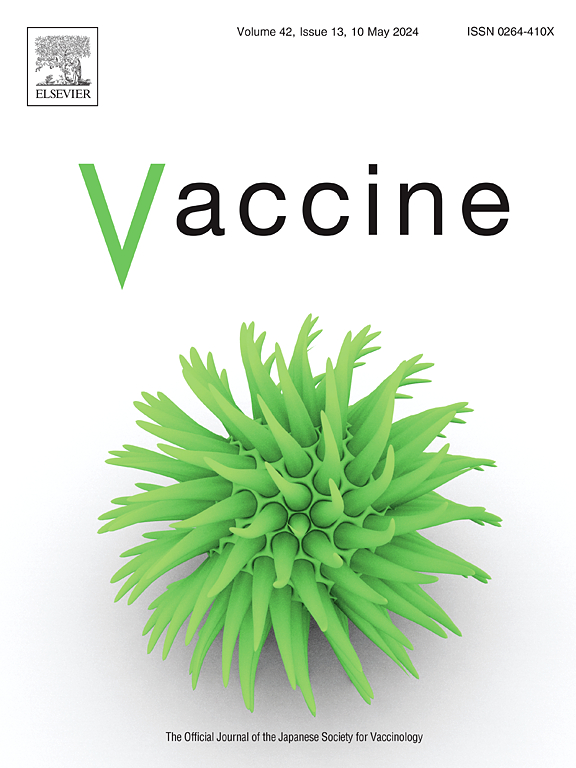2023-2024年美国两个州免疫功能低下个体的COVID-19疫苗接种情况
IF 4.5
3区 医学
Q2 IMMUNOLOGY
引用次数: 0
摘要
随着时间的推移,COVID-19疫苗的接种率有所下降,然而,很少有数据描述免疫功能低下者的接种率,他们仍然处于严重疾病的高风险中。我们评估了2023-2024年期间,在美国两个大州接种过COVID-19疫苗的免疫功能低下人群中XBB COVID-19疫苗的摄取情况。方法:使用与保险索赔相关的州疫苗登记处的数据,我们对截至2023年9月11日居住在加利福尼亚州或路易斯安那州的年龄≥6个月的个体进行了回顾性队列研究,这些个体(1)在HealthVerity报告的保险计划中有持续的药房和医疗登记,(2)符合疾病控制和预防中心中度或重度免疫功能低下(HIV/AIDS或原发性免疫缺陷)的标准,前一年有血液病恶性肿瘤,前两年内有实体器官或骨髓移植,或前210天内接受过免疫抑制治疗),以及(3)之前接受过至少一剂COVID-19疫苗。我们计算了截至2024年3月31日2023-2024年COVID-19疫苗接种的累积发病率,按州、年龄组和特定免疫功能低下状况分层。结果共321,896例(中位年龄55岁;57%为女性)和43250人(中位年龄45岁;在加州和路易斯安那州,免疫功能低下的个体分别符合选择标准(64%为女性)。在这两个州,最常见的免疫损害类别是使用免疫抑制疗法(分别在加利福尼亚州和路易斯安那州占78%和85%)。到2024年3月31日,只有21%的加州人和6%的路易斯安那人接种了2023-2024年的COVID-19疫苗。免疫损害条件下的摄取相似。在2023-2024年呼吸道病毒流行季,这两个州免疫功能低下人群的COVID-19疫苗接种率较低,只有不到21%的人接种了2023-2024年的疫苗。需要加强努力,提高这一弱势人群的COVID-19疫苗接种率。本文章由计算机程序翻译,如有差异,请以英文原文为准。
2023–2024 COVID-19 vaccine uptake among immunocompromised individuals in two US states
Background
Uptake of COVID-19 vaccines has declined over time, however, little data exist describing uptake among the immunocompromised who remain at high risk of severe disease. We evaluated XBB COVID-19 vaccine uptake during the 2023–2024 season among immunocompromised persons who had previously received a COVID-19 vaccine in two large, diverse US states.
Methods
Using data from state vaccine registries linked to insurance claims, we conducted a retrospective cohort study among individuals ≥6 months of age living in California or Louisiana as of September 11, 2023 who (1) had continuous pharmacy and medical enrollment in an insurance plan reported by HealthVerity, (2) met the Centers for Disease Control and Prevention criteria for moderately or severely immunocompromised (HIV/AIDS or primary immunodeficiency, hematologic malignancy in the prior year, solid organ or bone marrow transplant in the prior two years, or use of immunosuppressive therapy in the prior 210 days), and (3) previously received at least one dose of COVID-19 vaccine. We calculated the cumulative incidence of 2023–2024 COVID-19 vaccine receipt through March 31, 2024, stratified by state, age group, and specific immunocompromising condition.
Results
A total of 321,896 (median age 55 years; 57 % female) and 43,250 (median age 45 years; 64 % female) immunocompromised individuals met selection criteria in California and Louisiana, respectively. In both states, the most common immunocompromising category was the use of immunosuppressive therapy (78 % and 85 % of individuals in California and Louisiana, respectively). Only 21 % of individuals in California and 6 % of individuals in Louisiana received a 2023–2024 COVID-19 vaccine by March 31, 2024. Uptake was similar across immunocompromising conditions.
Discussion
During the 2023–2024 respiratory virus season, COVID-19 vaccine uptake among the immunocompromised in these 2 states was low, with fewer than 21 % receiving a 2023–2024 dose. Enhanced efforts to increase COVID-19 vaccine uptake in this vulnerable population are needed.
求助全文
通过发布文献求助,成功后即可免费获取论文全文。
去求助
来源期刊

Vaccine
医学-免疫学
CiteScore
8.70
自引率
5.50%
发文量
992
审稿时长
131 days
期刊介绍:
Vaccine is unique in publishing the highest quality science across all disciplines relevant to the field of vaccinology - all original article submissions across basic and clinical research, vaccine manufacturing, history, public policy, behavioral science and ethics, social sciences, safety, and many other related areas are welcomed. The submission categories as given in the Guide for Authors indicate where we receive the most papers. Papers outside these major areas are also welcome and authors are encouraged to contact us with specific questions.
 求助内容:
求助内容: 应助结果提醒方式:
应助结果提醒方式:


